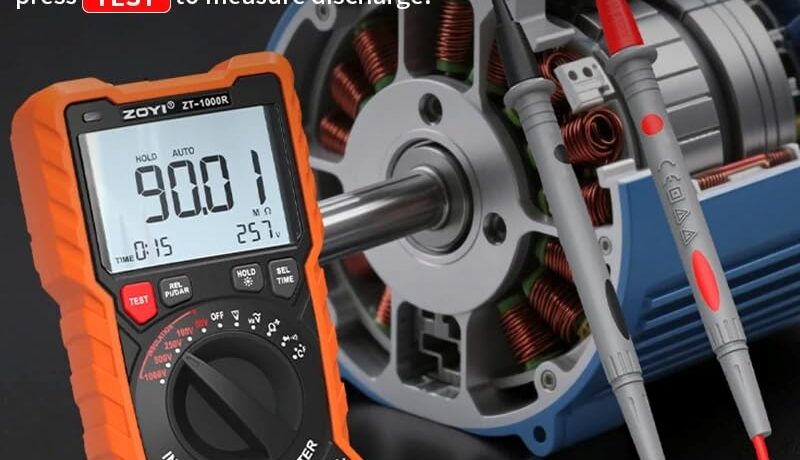Subtotal: £28.98
ZOYI ZT-1000R: the insulation resistance tester multimeter electricians actually use
When you’re commissioning a circuit, diagnosing leakage, or checking motor windings, you need an insulation resistance tester multimeter that’s accurate, fast, and safe. The ZOYI ZT-1000R combines a full True-RMS DMM with a professional megohmmeter, giving you 50–1000 V test voltages, PI/DAR capability, and a 19,999-count display in one compact body. It’s a versatile tool for domestic, commercial, and solar PV work.
ZT-1000R at a glance (key specs)
- Insulation test voltages: 50 V, 100 V, 250 V, 500 V, 1000 V
- Insulation resistance range: up to 20 GΩ (varies by kit/region)
- Multimeter functions: True-RMS AC/DC voltage, resistance, capacitance, frequency, temperature, continuity/diode; 19,999-count display
- Sampling rate: approx. 2 readings/s
- Power: 3× 14500 rechargeable lithium cells
- Size/weight: 176 × 91 × 47 mm, ≈330 g
- Safety: Measurement Category CAT III (commonly listed as CAT III 1000 V)
Note: Always verify your unit’s markings and included accessories; ranges and kits can vary by region.
Why insulation testing matters (and where the ZT-1000R fits)
Good insulation keeps people safe and systems reliable. Whether you’re doing EICRs, troubleshooting nuisance RCD trips, or checking PV strings and motor windings, an insulation tester with selectable voltages and timed tests gives you data you can trust. The ZT-1000R’s 2-in-1 design means you carry one instrument for both general electrical measurements and high-voltage insulation checks, cutting kit weight and swap-over time.
Professional features that speed up your day
- PI/DAR testing: Run Polarisation Index and Dielectric Absorption Ratio checks to assess insulation condition over time—ideal for motors, cables, and switchgear.
- Five test voltages (50–1000 V): Match standards and manufacturer recommendations without over-stressing equipment under test.
- True-RMS multimeter built-in: No need to swap tools for voltage, resistance, capacitance, frequency, or temperature checks.
- Bright, backlit 19,999-count display: Clear readings in lofts, risers, and plant rooms.
- Rechargeable battery setup: Uses three 14500 cells—simple to replace and charge between jobs.
- Safety you can rely on: Built to CAT III standards. Always follow local regs and the product manual.
Typical use-cases
- Fixed-wire testing / EICR: 250 V or 500 V IR checks on circuits and spurs
- Motors & control panels: PI/DAR trends help flag moisture or ageing insulation
- Solar PV: Validate string insulation before commissioning and after faults
- Facilities maintenance: Quick leakage checks across lighting and power circuits
Quick guide: running a PI/DAR insulation test
- Isolate and discharge the circuit/equipment.
- Select test voltage (commonly 500 V or 1000 V) and PI/DAR mode.
- Connect leads: L–E or as per the equipment standard.
- Start test and monitor readings over 60 s (DAR) and 10 min (PI).
- Record results; compare to site history or manufacturer guidelines.
Always use the ZT-1000R’s manual for model-specific procedures and safety.
ZT-1000R vs carrying two instruments
A separate DMM plus a dedicated megohmmeter adds weight and costs time. The ZT-1000R’s 2-in-1 approach keeps your tool bag lighter (~330 g) and your workflow tighter—especially on repetitive checks across boards or strings.
Specs table (summary)
- Insulation test voltages: 50/100/250/500/1000 V
- Insulation range: up to 20 GΩ (varies by listing/kit)
- Display: 19,999 counts, backlit
- Functions: True-RMS AC/DC V, Ω, capacitance, frequency, temperature, diode/continuity
- Power: 3×14500 Li-ion (user-replaceable)
- Sampling: ~2 Hz
- Size/weight: 176 × 91 × 47 mm; ~330 g
- Safety: CAT III (commonly shown as CAT III 1000 V)
FAQs
Does the ZT-1000R support PI/DAR?
Yes—PI/DAR timing/ratio tests are provided for deeper insulation assessment.
What’s the max insulation resistance?
Up to 20 GΩ depending on the kit/region; check your manual for exact ranges.
What safety category is it?
CAT III (often stated as CAT III 1000 V). Always confirm on your unit’s label.

 ZOYI ZT-980E Digital Multimeter Transistor Tester
ZOYI ZT-980E Digital Multimeter Transistor Tester 